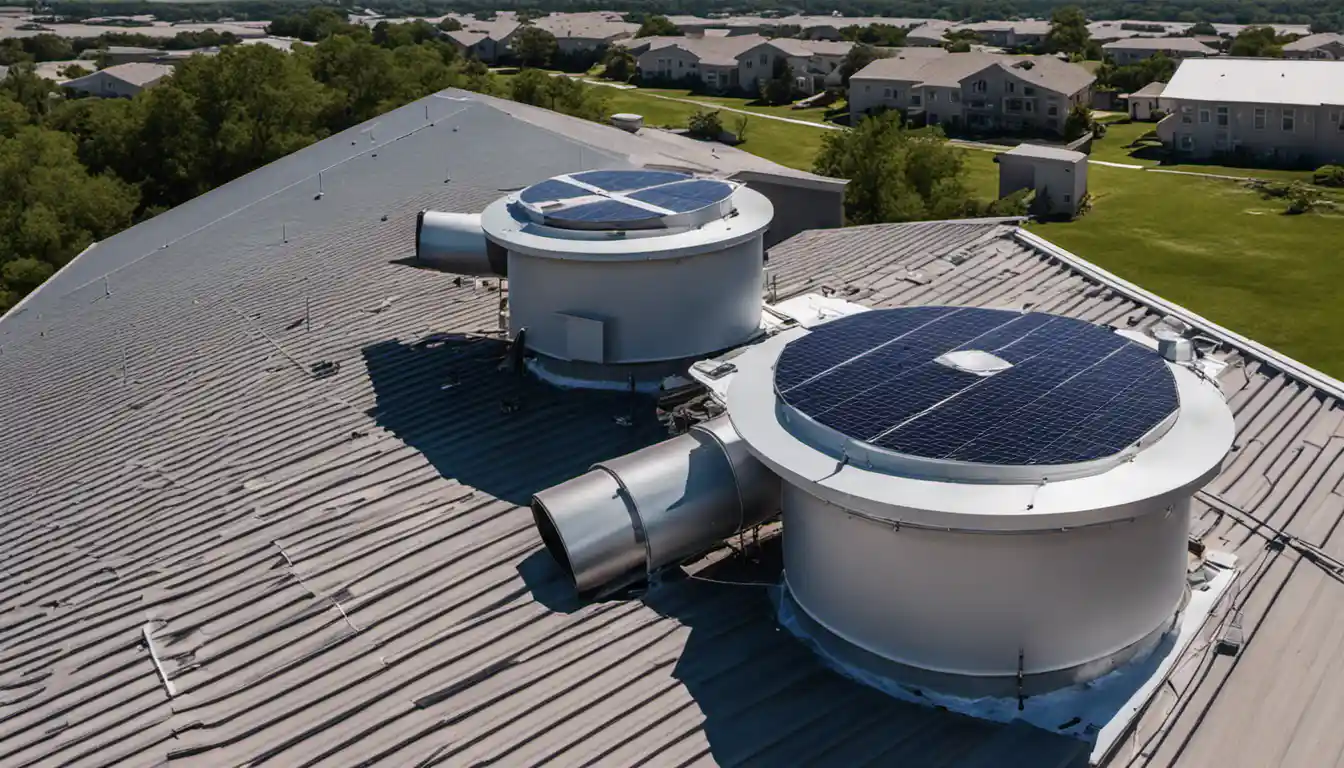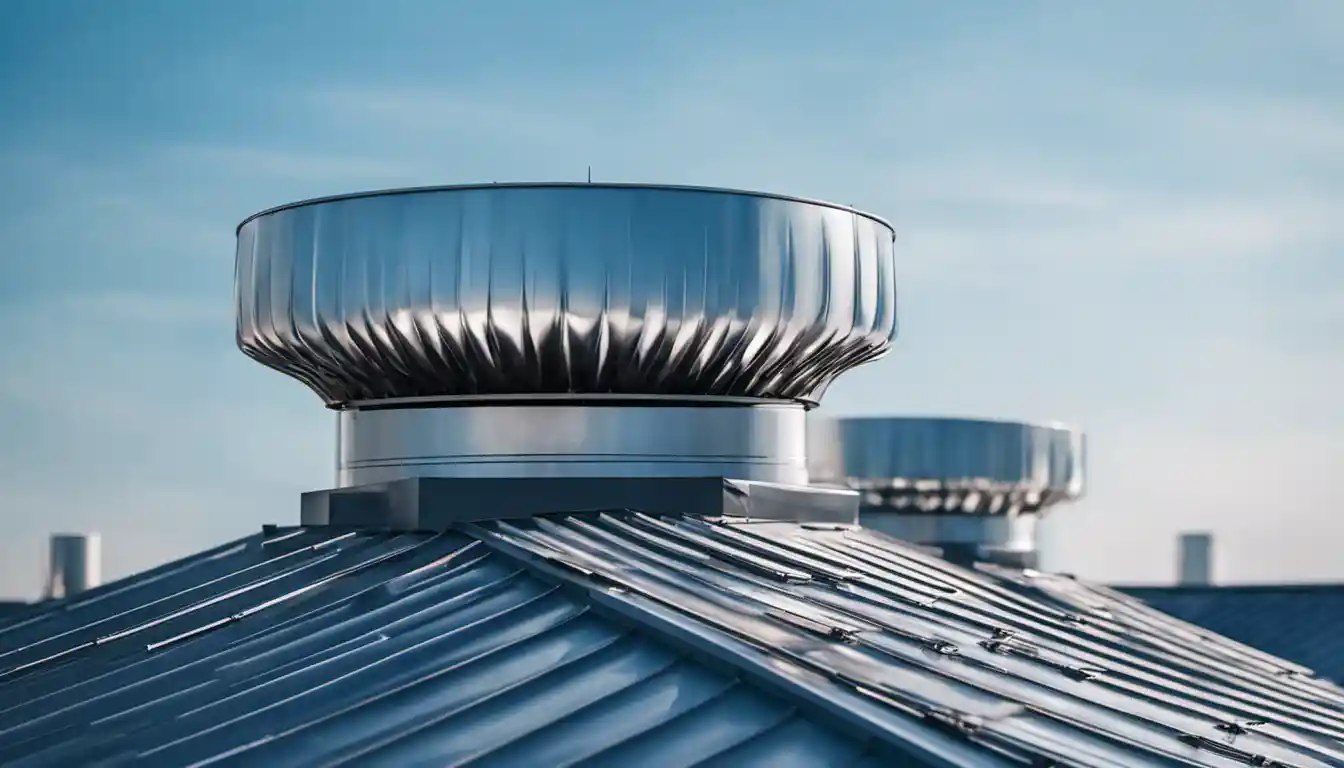Overview
Solar roof vents and turbine vents are both used for cooling and airing buildings but they operate differently. Solar roof vents run on solar power and maintain a steady airflow, making them more efficient and causing less wear and tear. On the other hand, turbine vents rotate to remove hot air, cost less and don’t require any power source, but their efficiency is dependent on wind speed.
Understanding Solar Roof Vents
Imagine you’re in the desert. The sun is beating down, making you hot and sweaty. Now, think of a cool drink in your hand. It’s the same sun that’s making you long for that drink. Now, imagine if the heat from that same sun could power a device to cool your house. That’s exactly what a solar roof vent does.
A solar roof vent, or solar attic fan, is a simple design: it’s a fan powered by the sun’s rays collected by a solar panel affixed to the fan. As the sun shines on the panel, it powers the fan which draws the hot air out from the inside of the home, thereby reducing the interior temperature.
Understanding Turbine Roof Vents
Turbine vents, often known as whirlybirds, work on a different principle. They’re a bit like those old-fashioned windmills you see in countryside paintings. When the wind blows, it turns the blades of the turbine, and that rotation sucks the hot air out from your home. Unlike solar ventilators, turbine ventilators don’t require any external power source to function. However, their efficiency significantly depends on wind speed.
Key Differences Between Solar and Turbine Roof Vents
Functionality and Performance
When it comes to “solar roof vent vs turbine” performance, both work well in their optimal conditions. However, solar vents are more consistent as their performance doesn’t depend on wind speed. Turbines, on the other hand, can become less effective during periods of low wind.
Installation and Maintenance

Both systems are relatively easy to install, particularly if you have existing vent openings in the roof. However, solar vents need access to sunlight, which could limit installation sites. In terms of maintenance, solar vents need less, as turbines have moving parts that can wear out or be damaged by high winds.
Energy Efficiency
Both vents remove hot air, reducing the need for air conditioning. Nevertheless, by using renewable solar energy, solar ventilators provide an extra level of energy efficiency above the turbine ventilator.
Costs and Long-term Savings
Turbines have a lower upfront cost than solar vents but may require more maintenance. Solar vents, while costlier, can lead to higher long-term savings thanks to lower maintenance costs and energy savings.
Advantages and Disadvantages
Advantages of Solar Roof Vents
Solar roof vents use free, abundant, and clean solar energy. They work throughout the day, require less maintenance, and contribute to lower energy bills.
Disadvantages of Solar Roof Vents
The major downside is the cost: solar vents are more expensive upfront than turbines. They also require sunlight to operate efficiently, which can be a challenge in less sunny climates.
Advantages of Turbine Roof Vents

Turbine vents are less expensive, easy to install, and don’t rely on sunlight, which means they can work around the clock as long as there’s wind.
Disadvantages of Turbine Roof Vents
Turbines depend on wind: no wind, no cooling. Their moving parts may require regular maintenance, and strong winds could potentially damage them.
Factors to Consider When Choosing Between Solar and Turbine Roof Vents
Climate and Weather Conditions
Sunlight and wind conditions in your location play a crucial role in the “solar ventilator vs turbine ventilator” decision. More sunny areas favor solar vents, while windy conditions may benefit turbines.
Roof Size and Design
Both vents work well in any roof design or size. But, solar vent efficiency might decrease if your roof doesn’t get enough sunlight.
Energy Consumption and Cost Efficiency

If reducing energy bills is your goal, solar ventilators will likely be the better choice.
Durability and Lifespan
Solar roof vents often boast a longer lifespan with less maintenance, making them a more durable option.
Case Studies and Real-World Comparisons
Real-life scenarios further illustrate the benefits and drawbacks of both ventilators. For instance, a house located in sunny Phoenix would benefit more from a solar vent Read: Solar roof vents pros and cons. Conversely, a home on a windy coastline where the wind blows strongly and consistently would receive significant benefit from a turbine vent.
Why Mixing Ventilation Systems is Not Recommended
This is like a band having two drummers—it rarely works. Having both solar and turbine vents could disrupt the airflow, weakening the efficiency of both systems.
Common Myths and Misconceptions
It’s not all sunny skies and perfect breezes in the world of solar and turbine vents. Misconceptions exist, such as solar vents making your home cold in winter (they don’t – a thermostat can control the temperature), or turbines making a lot of noise (they are quite quiet when maintained well).
High Temperature in the Attic: Solutions besides Ventilation
While vents greatly aid in reducing temperature, other solutions can supplement them, like insulation and radiant barriers.
Final Thoughts: Which One Should You Choose?
In sum, the choice between a solar roof vent and turbine largely depends on your situation and preferences. Consider factors like your local weather, the amount of sunlight your roof receives, your budget, and long-term energy savings. Also, remember to dispel any myths and misconceptions that exist about both types. With all these factors in mind, making a well-informed decision will be simple.
Remember, whether you choose solar roof vent or turbine, each one is a step towards a cooler and more energy-efficient home.



